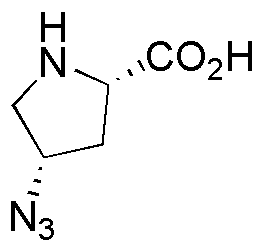(2S,4S)-Boc-4-azido-pyrrolidine-2-carboxylic acid is widely utilized in research focused on:
- Peptide Synthesis: This compound serves as a key building block in the synthesis of peptides, particularly in the development of novel therapeutic agents. Its azido group allows for click chemistry applications, facilitating the attachment of various functional groups.
- Drug Development: The unique structure of this compound makes it valuable in the pharmaceutical industry for creating prodrugs or drug candidates that require specific bioactivation, enhancing their efficacy and reducing side effects.
- Bioconjugation: Researchers use this chemical in bioconjugation processes, where it can be linked to biomolecules like proteins or antibodies. This application is crucial in developing targeted drug delivery systems and diagnostic tools.
- Material Science: Its properties are exploited in the creation of functionalized polymers and materials, which can be used in various applications, including coatings and drug delivery systems, offering improved performance and stability.
- Research in Chemical Biology: This compound is instrumental in studying biological processes and interactions at the molecular level, providing insights that can lead to advancements in understanding disease mechanisms and developing new therapies.
General Information
Properties
Safety and Regulations
Applications
(2S,4S)-Boc-4-azido-pyrrolidine-2-carboxylic acid is widely utilized in research focused on:
- Peptide Synthesis: This compound serves as a key building block in the synthesis of peptides, particularly in the development of novel therapeutic agents. Its azido group allows for click chemistry applications, facilitating the attachment of various functional groups.
- Drug Development: The unique structure of this compound makes it valuable in the pharmaceutical industry for creating prodrugs or drug candidates that require specific bioactivation, enhancing their efficacy and reducing side effects.
- Bioconjugation: Researchers use this chemical in bioconjugation processes, where it can be linked to biomolecules like proteins or antibodies. This application is crucial in developing targeted drug delivery systems and diagnostic tools.
- Material Science: Its properties are exploited in the creation of functionalized polymers and materials, which can be used in various applications, including coatings and drug delivery systems, offering improved performance and stability.
- Research in Chemical Biology: This compound is instrumental in studying biological processes and interactions at the molecular level, providing insights that can lead to advancements in understanding disease mechanisms and developing new therapies.
Documents
Safety Data Sheets (SDS)
The SDS provides comprehensive safety information on handling, storage, and disposal of the product.
Product Specification (PS)
The PS provides a comprehensive breakdown of the product’s properties, including chemical composition, physical state, purity, and storage requirements. It also details acceptable quality ranges and the product's intended applications.
Certificates of Analysis (COA)
Search for Certificates of Analysis (COA) by entering the products Lot Number. Lot and Batch Numbers can be found on a product’s label following the words ‘Lot’ or ‘Batch’.
*Catalog Number
*Lot Number
Certificates Of Origin (COO)
This COO confirms the country where the product was manufactured, and also details the materials and components used in it and whether it is derived from natural, synthetic, or other specific sources. This certificate may be required for customs, trade, and regulatory compliance.
*Catalog Number
*Lot Number
Safety Data Sheets (SDS)
The SDS provides comprehensive safety information on handling, storage, and disposal of the product.
DownloadProduct Specification (PS)
The PS provides a comprehensive breakdown of the product’s properties, including chemical composition, physical state, purity, and storage requirements. It also details acceptable quality ranges and the product's intended applications.
DownloadCertificates of Analysis (COA)
Search for Certificates of Analysis (COA) by entering the products Lot Number. Lot and Batch Numbers can be found on a product’s label following the words ‘Lot’ or ‘Batch’.
*Catalog Number
*Lot Number
Certificates Of Origin (COO)
This COO confirms the country where the product was manufactured, and also details the materials and components used in it and whether it is derived from natural, synthetic, or other specific sources. This certificate may be required for customs, trade, and regulatory compliance.


